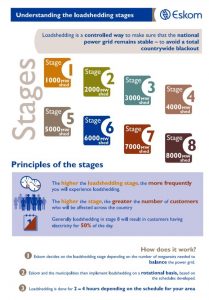- Mon - Fri: 8:00 - 16:30
South Africans should brace themselves for the worst year of load-shedding yet in 2021, with Stage 8 being a possibility before the end of winter. This is the view of power and mining expert Ted Blom, who spoke to the Free Market Foundation’s Chris Hattingh during the latest episode of the Free Marketeers podcast.
By BizNews
“When Eskom says we are having Stage 1 load-shedding or shedding 1,000MW, to the economy it is in fact a 3,000MW shortage,” Blom said.
He stated that by Eskom’s rules of engagement, Stage 1 would be implemented when up to 1,000MW would need to be shed, Stage 2 when up to 2,000MW needed to be shed, and so on.
While Eskom has over the past week said it is shedding at Stage 2, Blom said it has consistently been over 2,000MW short, which technically means Stage 3 is in effect.
“So in actual fact, if you add the numbers together, it’s the 2,000MW from the interruptible chaps, plus 2,000MW from the public, plus the residual for which they are over 2,000MW,” Blom stated.
“That in fact makes it about Stage 5 load-shedding if Eskom was more transparent and honest in its dealings with the public,” he said.
What happens at Stage 8
Stage 8 load-shedding is implemented when 8,000MW needs to be shed from the national grid in order to prevent a total collapse of the system. During stage 8, consumers can expect much more frequent power cuts, to be without electricity for 48 hours over four days, or 50% of the time. The worst level of load-shedding previously experienced in South Africa was Stage 6, which was implemented in December 2019 after a technical problem at Medupi Power Station. At the time, Eskom needed to shed 6,000MW, which meant that around 40% of its capacity had been unavailable.
The infographic below provides more details regarding Eskom’s load-shedding stages.

Eskom updated response
Eskom has told MyBroadband that while it endeavours to only load shed at Stage 4 or below and only when truly necessary, higher stages of load shedding could be required.
This would be the case if there are numerous, simultaneous breakdowns of generating units and depleted fuel levels at the OCGT (open cycle gas turbines) and pumped storage power stations.
“In the planning scenarios considered, at an unplanned unavailability of up to 14,000 MW of capacity, up to Stage 3 load-shedding is possible,” Eskom said.
“However, if this coincides with depleted fuel at pumped storage and OCGT power stations, higher stages of load-shedding are possible,” it added.
Source:
Proudly South African company specialising in affordable premium alternative energy products based in Gauteng.
